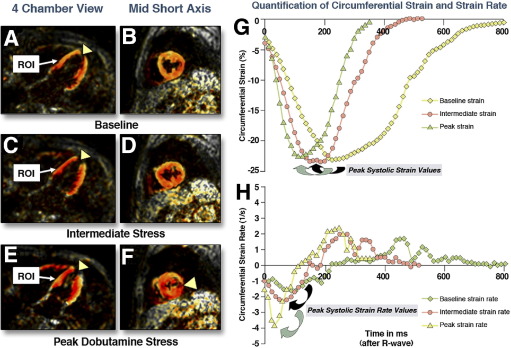

Strain-encoded CMR for the detection of inducible ischemia during intermediate stress
Objectives: This study sought to evaluate the diagnostic accuracy of strain-encoded cardiac magnetic resonance (SENC) for the detection of inducible ischemia during intermediate stress. Background: High-dose dobutamine stress cardiac magnetic resonance (DS-CMR) is a well-established modality for the noninvasive detection of coronary artery disease (CAD). However, the assessment of cine scans relies on the visual interpretation of wall motion, which is subjective, and modalities that can objectively and quantitatively assess the time course of myocardial strain response during stress are lacking. Methods: Stress-induced ischemia was assessed by wall motion analysis and by SENC in 80 patients with suspected or known CAD and in 18 healthy volunteers who underwent DS-CMR in a clinical 1.5-T scanner. Quantitative coronary angiography was used as the standard reference for the presence of CAD (<50% diameter stenosis). Results: On a patient level, 46 of 80 patients (58%) had CAD, including 20 with single-vessel, 18 with 2-vessel, and 8 with 3-vessel disease. During peak stress, SENC correctly detected ischemia in 45 versus 38 of 46 patients with CAD (7 additional correct findings for SENC), yielding significantly higher sensitivity than cine (98% vs. 83%, p < 0.05). No patients were correctly diagnosed by cine and missed by SENC. During intermediate stress, SENC showed diagnostic value similar to that provided by cine imaging only during peak dobutamine stress (sensitivity of 76% vs. 83%, specificity of 88% vs. 91%, and accuracy of 81% vs. 86%; p = NS for all). Quantification analysis demonstrated that strain rate response is a highly sensitive marker for the detection of inducible ischemia (area under the curve = 0.96; SE = 0.01; 95% confidence interval: 0.93 to 0.99) that precedes the development of inducible wall motion abnormalities and already significantly decreases with moderate 40% to 60% coronary lesions. Conclusions: Using SENC, CAD can be detected during intermediate stress with similar accuracy to that provided by cine only during peak stress. By this approach, patient safety may be improved during diagnostic procedures within lower time spent (Strain-Encoded Cardiac Magnetic Resonance Imaging for Dobutamine Stress Testing. © 2010 American College of Cardiology Foundation.



